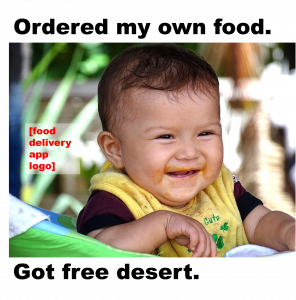Memes in class? Using multimodal texts to feed open-ended creativity
Georgia-Zozeta Miliopoulou
What is the idea?
In 1976, Richard Dawkins defined memes as units of cultural transmission or imitation (Dawkins, 1976, p. 192) and later described memes as mutating patterns of information (Dawkins, 1986, p. 158). Memes have also been approached as replicators or representations and have been described as viruses becoming endemic within or between generations (Sperber 1996, p. 24-32 and p. 57-58).
The internet meme, usually consisting of a photo or image and a caption, appears to be all the above: a cultural transmission of ideas or feelings, spreading virally and constituting patterns of information. Though more limited in form, the internet meme has become extremely popular among young people (Jakubowski, 2021; Penney, 2020).
Memes can be used as tools for active learning almost by definition, since they act as units of cultural transmission, replicators, or patterns of information. By processing thoughts and ideas to be conveyed through a popular form, students may reflect on significant topics while engaging in a familiar activity.
Active learning includes methods of instruction which engage students in the learning process through meaningful and reflective activities (Bonwell & Eison, 1991) while fostering diversity and acknowledging differences of opinion and ways of thinking (McKeachie et al., 2006). Active learning fosters engagement and one of the ways to achieve this is introducing activity into the traditional lecture (Prince, 2004).
Meme-making can allow students to express their thoughts and demonstrate understanding of taught topics multimodally, to compare such thoughts, and to assimilate learning material through a critical lens. Memes in class have been found to promote critical thinking (Wells, 2018) and visual literacy (Romero & Bobkina, 2017), as well as in the peer review of chemistry exams (Underwood & Kararo, 2020) and in Pharmacy (Brown, 2020). In most of these cases, creating was meant to facilitate understanding of key topics.
In the activity we propose, students are asked to create memes to develop their creative skills, particularly in the context of marketing communications and creative advertising, an idea also considered by Dawkins himself and the advertising agency Saatchi & Saatchi (Solon, 2013). They actively engage in the learning of creating advertising. The students are asked to create memes during class time. They may be given a visual; or they may be given a topic. Then, they are asked to improvise adding captions to images or images to sentences to provide a resonant meme. Given the right prompts and instructions, students can engage in an intuitive activity, test and develop their skills in the context of active learning.
Why this idea?
This is a classroom activity. Students can use their mobile phones – legitimately! They may select an app they already use or download a free meme generator application. The activity unfolds as follows:
The instructor gives students a visual. This could be a product or, even better, something completely irrelevant that would trigger combinational creativity (Boden, 2001).
The instructor gives students 10-15 minutes to find unexpected captions for this visual, which promote a product or social cause.
Afterwards, the students share at least one of their memes in class and provide feedback on the experience.
Bringing memes in class can be fun and help students achieve important learning outcomes like:
Understanding the interplay between words and images in the context of creative advertising, while connecting this understanding to visual rhetoric and visual semiotics (Sturken & Cartwright, 2001; Rose, 2001).
Analysing rhetoric tropes that appear in different memes, familiarising themselves with metaphors, metonymies, ironies, etc (McQuarrie & Phillips, 2008).
Developing their critical skills and assessing their cultural capital by isolating and analysing the components of a meme and by tracing the cultural references that lurk in either text or image thus engaging with social constructionism (Miltner & Highfield, 2017).
Understanding polysemy and the role of cultural context in the appreciation of each meme (McQuarrie & Phillips, 2008).
Transferring this skill in creating advertising or branded content for online and offline purposes while discussing the resonance and impact of media content (user or brand generated) in their everyday life.
Applying the learning of combinational creativity and rhetoric tropes, in practice (Boden, 2001).
How could others implement this idea?
Before each exercise, the instructor discusses how memes emerged and how they came to be defined in the new media environment. They may ask students to download a meme generator application on their laptop or mobile phone. The instructor also discusses how memes can be of use in exploring cultural trends. The instructor may then connect memes to broader course related theory, by referring to theories of (indicatively) semiotics; visual rhetoric and visual sociology; social constructionism; media effects and advertising effects, creativity studies etc.
Then, the instructor introduces the activity and allows students some time to think individually. Possible ways to proceed could be:
- Giving students a topic like “first day at school” and asking them to find appropriate visuals to bear this or a similar caption
- Giving students a visual and asking them to add text, describing any feeling or situation
- Giving students a situation or emotional or mental state and asking them to find both text and image to convey it in a resonant manner
The students should work individually, under some time constraint because a degree of pressure usually motivates them to think more intensively.
The students share their memes, and the instructor might then discuss:
a) About the process
-
- The time limitation, pressure, and its impact on creative thinking
- The role of inspiration and the role of constraints as these were given in the prompt
b) About the outcomes
-
- How different the memes were
- Perceptions of originality and creativity when the same people have the same task and must follow similar patterns or use the same raw material
c) About the connections with theory
-
- As discussed above
Transferability to different contexts
This activity was initially designed to trigger students who study creative advertising. We have also used it for topics in Public Relations, digital & social media content. As discussed, this activity is also useful to students in visual sociology, visual studies, and graphic design. Though the activity per se does not change, the instructor should put it in context both before and after, to ensure relevance and connection to the learning outcomes. Choosing discipline specific prompts is important and will help contextualise the experience thus leading to both active and experiential learning.
Example of student output
For the student work, Creative Commons licensed images were used and all brand names were removed.



Links to tools and resources
- The Making of “Just For Hits” (2013 Saatchi & Saatchi New Directors’ Showcase) by Richard Dawkins & Marshmallow Laser Feast https://www.youtube.com/watch?v=_3sT3B4pF5s
- Mobile apps for meme creators: https://memegenerator.net/; GATM Meme Generator; Mematic.
References
Boden, M.A. (2001). Creativity and knowledge. In A. Craft, B. Jeffrey & M. Leibling (Eds.), Creativity in Education (pp. 95-102). Continuum.
Bonwell, C. C., & Eison, J. A. (1991). Active learning: Creating excitement in the classroom. 1991 ASHE-ERIC higher education reports. ERIC Clearinghouse on Higher Education, The George Washington University.
Brown, J.D. (2020). What do you meme, professor? An experiment using “memes” in pharmacy education. Pharmacy, 8(4), 202. http://dx.doi.org/10.3390/pharmacy8040202
Dawkins, R. (1976). The selfish gene. Oxford University Press.
Dawkins, R. (1986). The blind watchmaker. W.W. Norton and Company
Jakubowski, J. (2021). Political socialization in meme times: Adolescents and the sources of knowledge concerning politics. Review of Education, Pedagogy, and Cultural Studies, 43(3), 254–274. https://doi.org/10.1080/10714413.2021.1872315
McKeachie, W. J., Svinicki, M. D., & Hofer, B. K. (2006). McKeachie’s teaching tips: strategies, research, and theory for college and university teachers (12th ed., Ser. College teaching series). Houghton Mifflin.
McQuarrie, E.F., & Phillips, B.J. (2008). Go figure! New directions in advertising rhetoric. Sharpe.
Miltner, K.M., & Highfield, T. (2017). Never gonna gif you up: Analyzing the cultural significance of the animated gif. Social Media and Society, 3(3). https://doi.org/10.1177/2056305117725223
Penney, J. (2020). It’s so hard not to be funny in this situation: Memes and humor in U.S. youth online political expression, Television & New Media, 21(8), 791–806. https://doi.org/10.1177/1527476419886068.
Prince, M. (2004). Does active learning work? A review of the research, Journal of Engineering Education, 93(3), 223–231. https://doi.org/10.1002/j.2168-9830.2004.tb00809.x
Romero, E.D., & Bobkina, J. (2017). Teaching visual literacy through memes in the language classroom. In K. Donaghy & D. Xerri (Eds.), The image in English language teaching (pp. 59-69). Malta: ELT Council.
Rose, G. (2001). Visual methodologies. An introduction to the interpretation of visual materials. Sage.
Solon, O. (2013, June 20) Richard Dawkins on the internet’s hijacking of the word ‘meme’. Wired. http://www.wired.co.uk/article/richard-dawkins-memes
Sperber, D. (1996). Explaining culture: A naturalistic approach. Blackwell.
Sturken, M., & Cartwright, M. (2001). Practices of looking: An introduction to visual culture. Oxford University Press.
Underwood, S.M., & Kararo, A.T. (2020). Using memes in the classroom as a final exam review activity. Journal of Chemistry Education, 97, 1381–1386. https://doi.org/10.1021/acs.jchemed.0c00068
Wells, D. D. (2018). You all made dank memes: Using internet memes to promote critical thinking, Journal of Political Science Education, 14(2), 240–248. https://doi.org/10.1080/15512169.2017.1406363
Image Attributions
Richard Dawkins meme by Redwoodneo is used under CC BY-SA 3.0 licence: https://commons.wikimedia.org/wiki/File:Dawkins-Memes.jpg (Wikimedia Commons)
Figure 1. Student example using photo of Vermeer’s Girl with Pearl Earring by Geheugen van Nederland is based on https://commons.wikimedia.org/wiki/File:Girl_with_a_Pearl_Earring.jpg (Wikimedia Commons)
Figure 2. Student example is based on https://commons.wikimedia.org/wiki/File:The_Hills_Are_Alive_With_The_Sound_of_Music._Tracey_Bell_impersonates_Julie_Andrews_(14964254648).jpg (Wikimedia Commons)
Figure 3. Student example is based on https://commons.wikimedia.org/wiki/File:Baby_Boy_at_Lunch_-_Zipolite_-_Oaxaca_-_Mexico_(14983154344).jpg (Wikimedia Commons)



